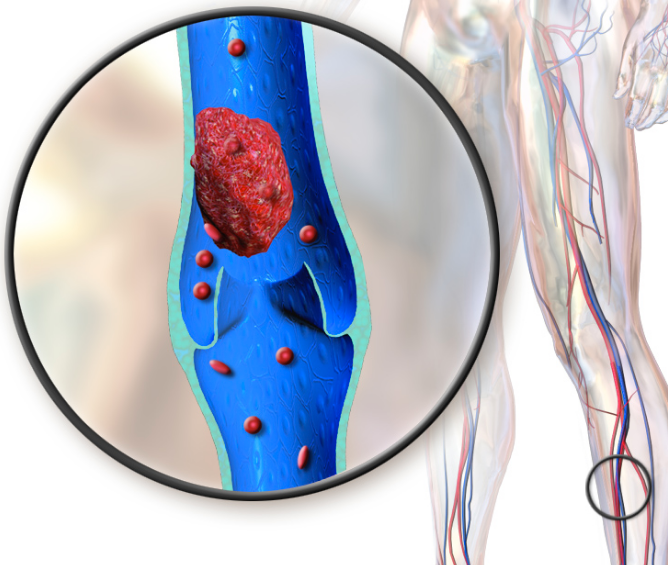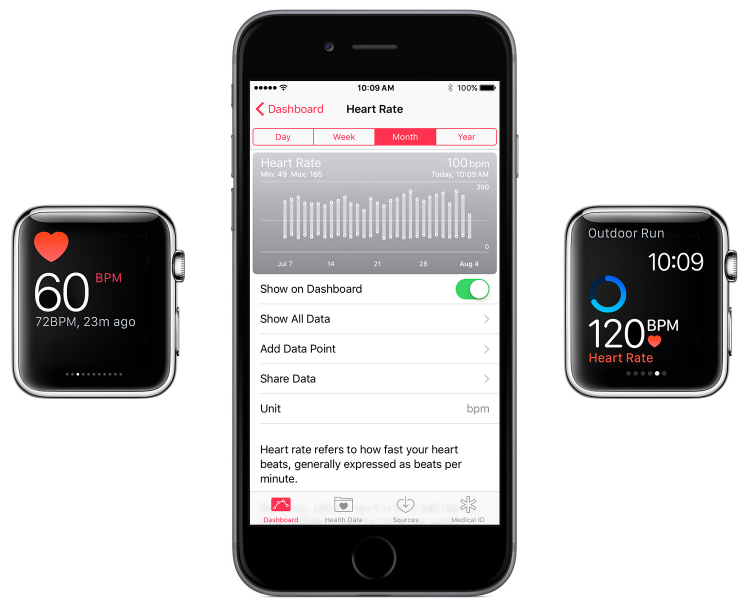Why prolonged sitting may increase risk of death
July 29, 2016
American Heart Association | Signs and Symptoms of VTE
Prolonged sitting, such as watching a lot of television every day, may increase your risk of dying from a blood clot in the lung, according to a new open-access research letter published July 26 in the American Heart Association’s journal Circulation.

Deep vein thrombosis (credit: Blausen.com staff)
A lung blood clot (pulmonary embolism) usually begins as a clot in the leg or pelvis as a result of inactivity and slowed blood flow (deep vein thrombosis). If the clot breaks free, it can travel to a lung and become lodged in a small blood vessel, where it is especially dangerous.
From 1988 to 1990, Japanese researchers asked 86,024 participants, age 40-79, how many hours they spent watching TV. Over the next 19 years, 59 participants died of a pulmonary embolism*.
The researchers found that compared to participants who watched TV less than 2.5 hours each day, deaths from a pulmonary embolism increased by 70 percent among those who watched TV from 2.5 to 4.9 hours; by 40 percent for each additional 2 hours of daily TV watching; and 2.5 times among those who watched TV 5 or more hours.
“Pulmonary embolism occurs at a lower rate in Japan than it does in Western countries, but it may be on the rise,” said Hiroyasu Iso, M.D., Ph.D., professor of public health at Osaka University Graduate School of Medicine and study corresponding author. “The Japanese people are increasingly adopting sedentary lifestyles, which we believe is putting them at increased risk.”

Apple Watch heart rate measure (credit: Apple)
Authors noted that the risk is likely greater than the findings suggest. Deaths from pulmonary embolism are believed to be underreported because diagnosis is difficult. The most common symptoms of pulmonary embolism — chest pain and shortness of breath — are the same as other life-threatening conditions, and diagnosis requires imaging that many hospitals are not equipped to provide.
How my Apple Watch’s heart rate monitoring saved my life (Macworld)
Other risks factors studied were obesity (the strongest link after hours sitting), diabetes, cigarette smoking, and hypertension.
The researchers said the findings may be particularly relevant to Americans, since U.S. adults watch more television — especially “binge watching” — than Japanese adults (according to another study).
The researchers advised a few simple steps to avoid a pulmonary embolism: “After an hour or so, stand up, stretch, walk around, or while you’re watching TV, tense and relax your leg muscles for 5 minutes (similar to that given to travelers on long plane flights), keep hydrated, and shed pounds if overweight.
An hour of moderate exercise a day enough to counter health risks from prolonged sitting
University of Cambridge researchers, in another new study published July 27 in Lancet, noted that recent estimates suggest that more than 5 million people die globally each year as a result of failing to meet recommended daily activity levels.
But they found that 60 to 75 minutes of moderate intensity exercise per day were sufficient to eliminate the increased risk of early death associated with sitting for over eight hours per day, based on an analysis of 16 studies, which included data from more than one million men and women.** (Three out of four people in the study failed to reach this level of daily activity, though.)
The greatest risk of early death was for those individuals who were physically inactive. They were between 28% and 59% more likely to die early compared with those who were in the most active quartile — a risk similar to that associated with smoking and obesity. In other words, lack of physical activity is a greater health risk than prolonged sitting.
The enormous economic burden of physical inactivity — a global pandemic
Another study, also published July 27 in Lancet, revealed that in 2013, physical inactivity cost INT $67.5 billion*** (in international dollars = what U.S. dollars could buy in 2013) globally in healthcare expenditure and lost productivity in 142 countries, representing 93.2 per cent of the world’s population. The study was based on the direct health-care cost, productivity losses, and disability-adjusted life years (DALYs) for five major non-communicable diseases attributable to inactivity: coronary heart disease, stroke, type 2 diabetes, breast cancer and colon cancer.
* The study, which is part of the Japan Collaborative Cohort Study funded by the Ministry of Education, Science, Sports and Culture of Japan, was conducted before computers, tablets and smartphones became popular sources of information and entertainment. The researchers believe new studies are needed to determine the effect of these new technologies on pulmonary embolism risk.
** The researchers acknowledge that there are limitations to the data analyzed, which mainly came from participants aged 45 years and older and living in western Europe, the U.S. and Australia. But the researchers asked all included studies to reanalyze their data in a harmonized manner, an approach that has never before been adopted for a study of this size and therefore also provides much more robust effect estimates compared with previous studies.
*** Cost breakdown:
$67.5bn: Total costs, including $53.8bn in direct cost (healthcare expenditure) and 13.7bn in indirect costs (productivity losses).
$31.2bn: Total loss in tax revenue through public healthcare expenditure
$12.9bn: Total amount in private sector pays for physical inactivity-related diseases (e.g. health insurance companies)
$9.7bn: Total amount households paid out-of-pocket for physical inactivity-related diseases
Type 2 Diabetes was the costliest disease, accounting for $37.6bn (70 percent) of direct costs.
Abstract of Watching Television and Risk of Mortality From Pulmonary Embolism Among Japanese Men and Women
Although case series reporting pulmonary embolism or deep vein thrombosis after prolonged television watching have been published, no prospective study has examined the association between time spent watching television and the risk of mortality from pulmonary embolism. We examined this association in a large cohort study of Japanese men and women.
Abstract of Does physical activity attenuate, or even eliminate, the detrimental association of sitting time with mortality? A harmonised meta-analysis of data from more than 1 million men and women
Background: High amounts of sedentary behaviour have been associated with increased risks of several chronic conditions and mortality. However, it is unclear whether physical activity attenuates or even eliminates the detrimental effects of prolonged sitting. We examined the associations of sedentary behaviour and physical activity with all-cause mortality.
Methods: We did a systematic review, searching six databases (PubMed, PsycINFO, Embase, Web of Science, Sport Discus, and Scopus) from database inception until October, 2015, for prospective cohort studies that had individual level exposure and outcome data, provided data on both daily sitting or TV-viewing time and physical activity, and reported effect estimates for all-cause mortality, cardiovascular disease mortality, or breast, colon, and colorectal cancer mortality. We included data from 16 studies, of which 14 were identified through a systematic review and two were additional unpublished studies where pertinent data were available. All study data were analysed according to a harmonised protocol, which categorised reported daily sitting time and TV-viewing time into four standardised groups each, and physical activity into quartiles (in metabolic equivalent of task [MET]-hours per week). We then combined data across all studies to analyse the association of daily sitting time and physical activity with all-cause mortality, and estimated summary hazard ratios using Cox regression. We repeated these analyses using TV-viewing time instead of daily sitting time.
Findings: Of the 16 studies included in the meta-analysis, 13 studies provided data on sitting time and all-cause mortality. These studies included 1 005 791 individuals who were followed up for 2–18·1 years, during which 84 609 (8·4%) died. Compared with the referent group (ie, those sitting <4 h/day and in the most active quartile [>35·5 MET-h per week]), mortality rates during follow-up were 12–59% higher in the two lowest quartiles of physical activity (from HR=1·12, 95% CI 1·08–1·16, for the second lowest quartile of physical activity [<16 MET-h per week] and sitting <4 h/day; to HR=1·59, 1·52–1·66, for the lowest quartile of physical activity [<2·5 MET-h per week] and sitting >8 h/day). Daily sitting time was not associated with increased all-cause mortality in those in the most active quartile of physical activity. Compared with the referent (<4 h of sitting per day and highest quartile of physical activity [>35·5 MET-h per week]), there was no increased risk of mortality during follow-up in those who sat for more than 8 h/day but who also reported >35·5 MET-h per week of activity (HR=1·04; 95% CI 0·99–1·10). By contrast, those who sat the least (<4 h/day) and were in the lowest activity quartile (<2·5 MET-h per week) had a significantly increased risk of dying during follow-up (HR=1·27, 95% CI 1·22–1·31). Six studies had data on TV-viewing time (N=465 450; 43 740 deaths). Watching TV for 3 h or more per day was associated with increased mortality regardless of physical activity, except in the most active quartile, where mortality was significantly increased only in people who watched TV for 5 h/day or more (HR=1·16, 1·05–1·28).
Interpretation: High levels of moderate intensity physical activity (ie, about 60–75 min per day) seem to eliminate the increased risk of death associated with high sitting time. However, this high activity level attenuates, but does not eliminate the increased risk associated with high TV-viewing time. These results provide further evidence on the benefits of physical activity, particularly in societies where increasing numbers of people have to sit for long hours for work and may also inform future public health recommendations.
Funding: None.
Abstract of The economic burden of physical inactivity: a global analysis of major non-communicable diseases
Background: The pandemic of physical inactivity is associated with a range of chronic diseases and early deaths. Despite the well documented disease burden, the economic burden of physical inactivity remains unquantified at the global level. A better understanding of the economic burden could help to inform resource prioritisation and motivate efforts to increase levels of physical activity worldwide.
Methods: Direct health-care costs, productivity losses, and disability-adjusted life-years (DALYs) attributable to physical inactivity were estimated with standardised methods and the best data available for 142 countries, representing 93·2% of the world’s population. Direct health-care costs and DALYs were estimated for coronary heart disease, stroke, type 2 diabetes, breast cancer, and colon cancer attributable to physical inactivity. Productivity losses were estimated with a friction cost approach for physical inactivity related mortality. Analyses were based on national physical inactivity prevalence from available countries, and adjusted population attributable fractions (PAFs) associated with physical inactivity for each disease outcome and all-cause mortality.
Findings: Conservatively estimated, physical inactivity cost health-care systems international $ (INT$) 53·8 billion worldwide in 2013, of which $31·2 billion was paid by the public sector, $12·9 billion by the private sector, and $9·7 billion by households. In addition, physical inactivity related deaths contribute to $13·7 billion in productivity losses, and physical inactivity was responsible for 13·4 million DALYs worldwide. High-income countries bear a larger proportion of economic burden (80·8% of health-care costs and 60·4% of indirect costs), whereas low-income and middle-income countries have a larger proportion of the disease burden (75·0% of DALYs). Sensitivity analyses based on less conservative assumptions led to much higher estimates.
Interpretation: In addition to morbidity and premature mortality, physical inactivity is responsible for a substantial economic burden. This paper provides further justification to prioritise promotion of regular physical activity worldwide as part of a comprehensive strategy to reduce non-communicable diseases.
Funding: None.